Bajos del Toro is the land of waterfalls in Costa Rica. You could visit a different waterfall every day for weeks in this small town. But one of the most spectacular is Cascadas Pozo Azul. This property has a handful of different waterfalls, some for swimming and others so grand, they will leave you in awe. Cascadas Pozo Azul is best known for having the largest waterfall in the area. In this post, we’ll explain how to visit this set of waterfalls, including details on the challenging hike.
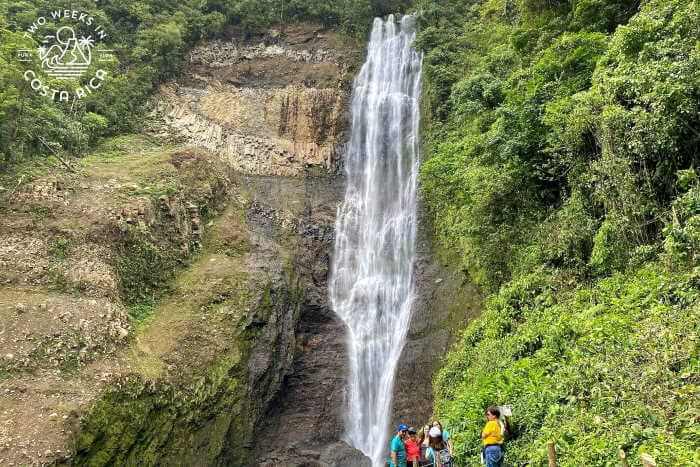
Background – Bajos del Toro Area
Cascadas Pozo Azul is located in Bajos del Toro, a very small town in the mountains north of San Jose. Bajos del Toro is on the back side of Poas, a wide crater volcano that is still active.
This region is high in altitude and covered in thick rainforest. Its plentiful rain feeds the many waterfalls and swimming holes you can find in the valley around town.
Cascadas Pozo Azul is a private property right off Route 108, the main road through Bajos del Toro. It is about a 20-minute drive from the small center of town.
Tip: Because Bajos del Toro is rural and most attractions are outside town, we highly recommend a rental car to explore the area. Check out our rental car discount to save 10% and get free extras. Opt for an SUV with higher clearance. There are lots of potholes on the local roads!
For more about the town of Bajos del Toro, read our destination guide, Bajos del Toro: Costa Rica’s Land of Waterfalls.
The Property
When you arrive at the property, you’ll come to a large rancho where you can buy your tickets. The local working will show you a trail map (we recommend taking a picture of it) and explain the property.
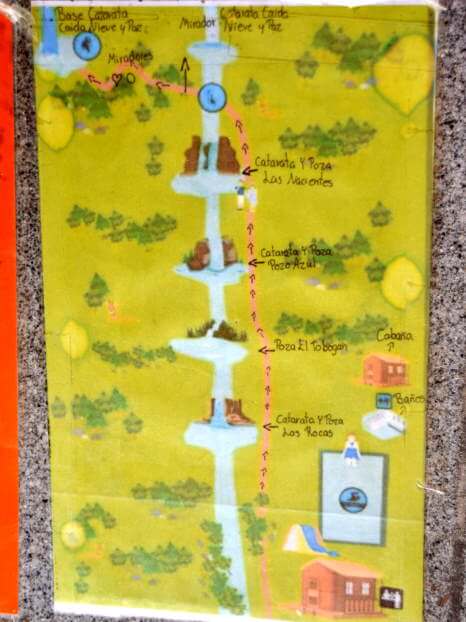
This is also where they serve lunch, which we highly recommend. See the Tips for Visiting section, below, for more information.
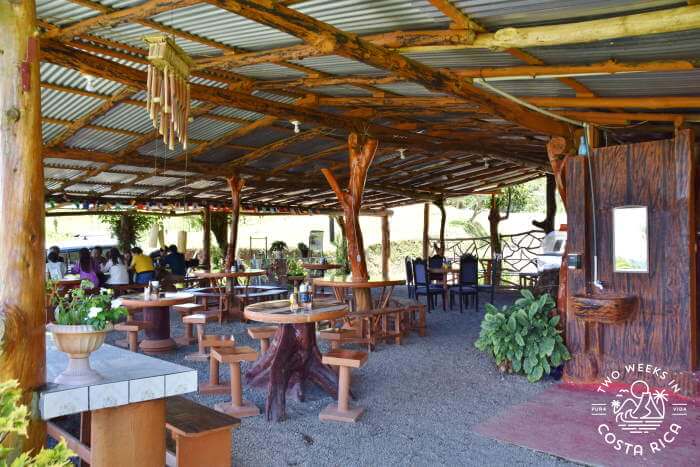
Overview of Trail Conditions
The trail starts right behind the rancho. Along well-manicured grass, you’ll follow the flags to the first three waterfalls and swimming holes.
The first part of the hike to see the smaller waterfalls is short and easy. There are some steps to get down to the waterfalls but not too many.
After visiting the smaller falls, the trail cuts into the thick forest. The hike becomes more difficult at this point. Reaching the largest waterfall, Catarata Caida Nieve y Paz, involves a steep walk down several hundred rustic steps.
The entire hike takes between 2-2.5 hours depending on how fast you go.
We cover more details below.
The First Set of Waterfalls
The waterfalls along the first part of the trail are smaller but still nice. They are called Catarata Las Rocas, Catarata Poza Azul, and Catarata Las Nacientes. These waterfalls and pools all flow along the same river in the same area so blend together.
Catarata Poza Azul and Catarata Las Rocas
Catarata Poza Azul (Blue Pool Waterfall) and Catarata Las Rocas (The Rocks Waterfall) is a group of gentle waterfalls and pools. The largest is 6.7 meters/22 feet tall.
From the trail, you first come to the top of a bunch of wispy waterfalls. These flows into a deep pool (4 meters/13 feet).
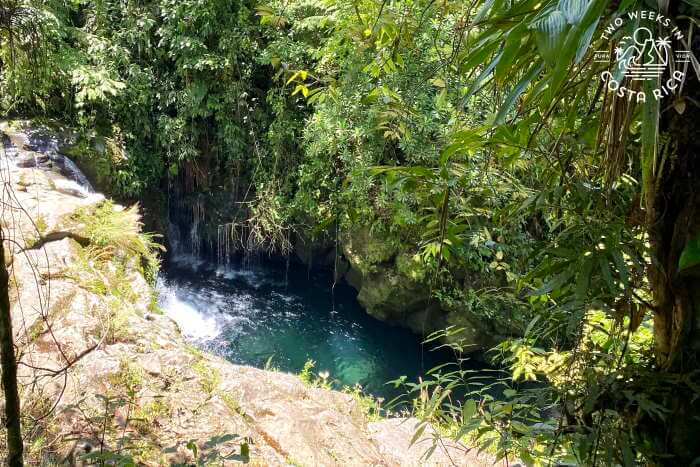
If you head left along the rocks, there’s another small cascade and pool. This is a popular spot with locals for swimming and hanging out, as the water is usually calm. You’ll also notice an old waterslide (tobogon in Spanish), but this wasn’t working on our visit in April 2022.
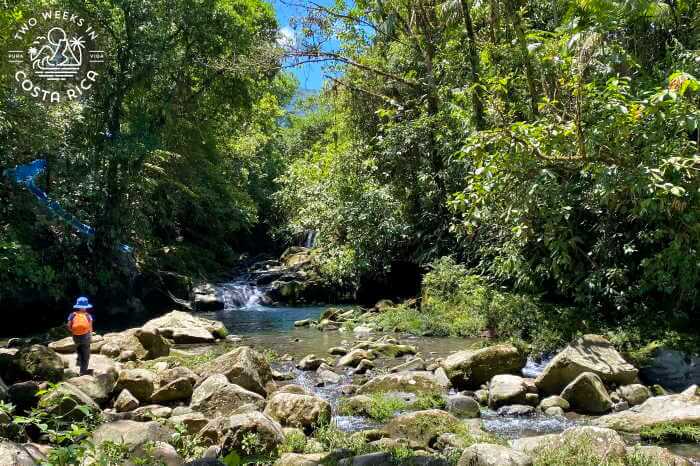
Catarata Las Nacientes
Catarata Las Nacientes (The Source/Springs Waterfall) is the next waterfall. This one is larger (16.5 meters/54 feet) and very pretty. There is actually one big waterfall and a few smaller ones beside it. They converge into a shallow blue-green pool.
The waterfalls are surrounded by moss-covered rock and thick green rainforest, making for a beautiful tropical backdrop.
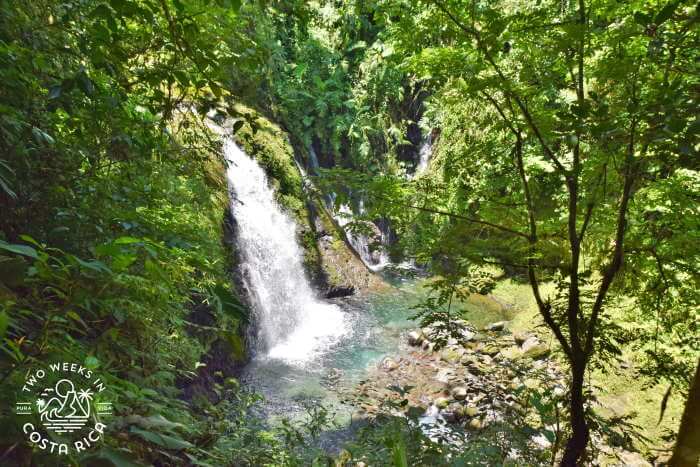
To get to the small pool, there are some smaller rocks to walk over. It isn’t too difficult, but the rocks can be slippery, so be careful.
Catarata Caida Nieve y Paz
The main attraction at Cascadas Pozo Azul is Catarata Caida Nieve y Paz (Waterfall of Falling Snow and Peace). It’s a fun, but challenging, adventure to reach this waterfall.
From the grassy trail, the path turns to dirt and heads into the rainforest.
The beginning part of the trail is fairly easy, with just a few ups and downs.
Cable Car
Soon, you’ll come to one of the most exciting parts of the hike: a cable car!
A river divides the trail, and to cross, you can either walk along some rocks or take a ride in a self-propelled cable car. Jenn and the kids opted to load into the cable car. It was fairly easy to pull themselves across the river and super fun.
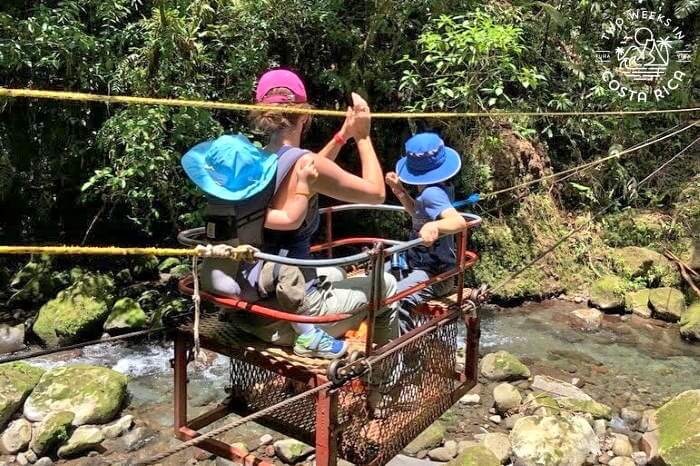
Miradors (Viewpoints)
On the other side, you follow along the river and soon arrive at a viewing platform. This looks down at the biggest waterfall on the property that you will hike to next, Catarata Caida Nieve y Paz.
The view from the small metal box looking down over the giant waterfall is breathtaking. You can see the water gush all the way down to the ground, then follow the path of the river.
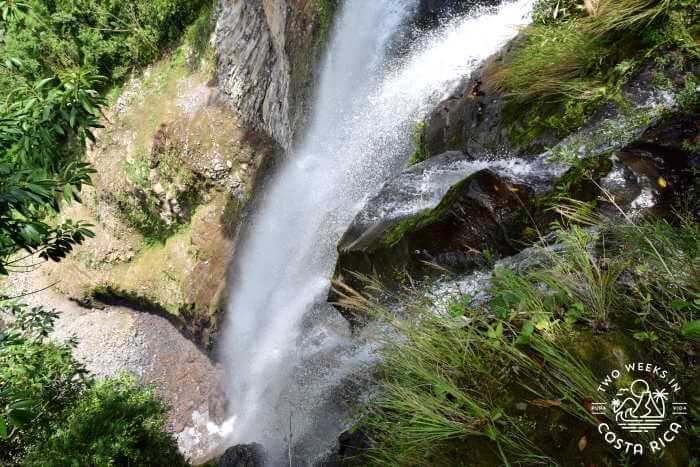
You’re hovering 155 meters (508 feet) up, and although the viewing platform looks well supported, we don’t recommend it for anyone with a fear of heights!
After the viewing platform, the trail goes up some more and leads to another lookout. This view is out to the lush green valley in the same direction of the waterfall. The focal point here is a couple of huge concrete structures in the shape of an O and a heart where you can take pictures.
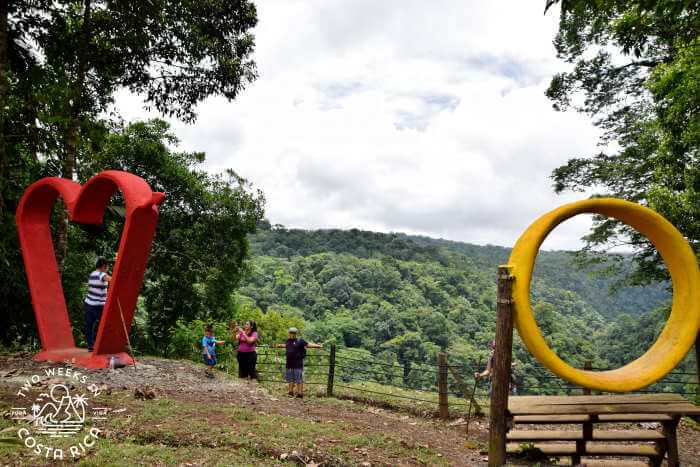
Be sure to fuel up with some water and food because right after this mirador, the trail gets tough.
Hike to the Largest Waterfall
Before starting this section of trail, there’s a sign that warns of the 350 steps and 600-meter (1,968-foot) descent.
The hike is indeed difficult, with many dirt steps, irregular terrain, rocks to maneuver, loose soil, and some slippery spots. But the trail is well-maintained and has handrails, which makes it a little easier.
It helps to use a walking stick. These were not available at the entrance, but it was easy enough to make some with sticks we found on the ground.
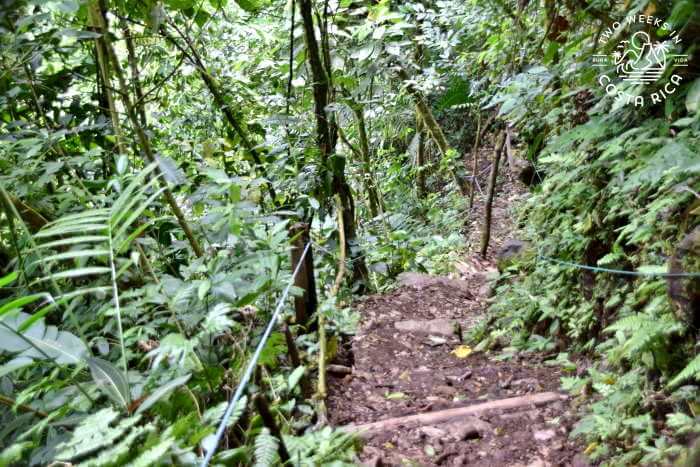
Jenn did the hike with our three-year old in the baby carrier. Our six-year old did it too, and there was another boy about the same age who also took on the challenge. Both were complaining for sure but managed to make it down to the waterfall and back up again.
Arriving at Catarata Caida Nieve y Paz
Once you get down to the waterfall, it’s well worth the effort.
The trail comes out of the jungle and opens to a wide viewing area. You can see the gigantic waterfall almost right away.
The powerful 155-meter (508-foot) falls flows over an ivory-colored sheet of rock in long wispy streaks. To the right are bright green shrubs and plants, the kind that feed on the constant nourishment of water.
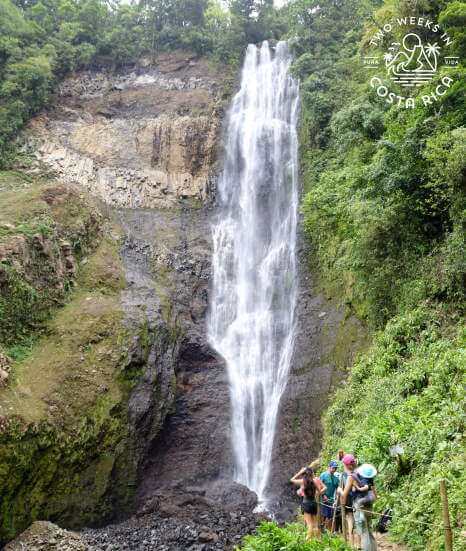
Looking back to the left, the waterfall drops into a wide rocky river. Surrounding the river is a sweeping valley full of tall, mature trees.
The property has put up a handrail to discourage people from walking down to the river. That didn’t stop a few from going on our visit anyway. Just remember that you don’t want to get stuck down there in the rain due to the chance of a flash flood. It’s best to stay up in the viewing area.
After admiring the waterfall, you’ll have the hardest part of the hike ahead of you. Going back up all the steps to the mirador took us about 40 minutes, with a few breaks along the way.
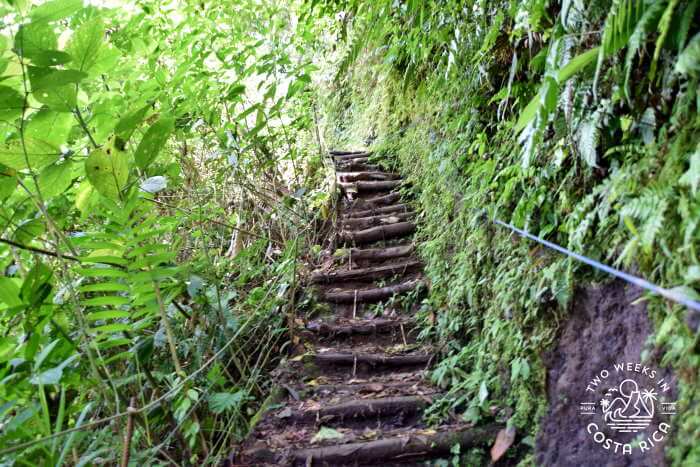
Tips and Information on Visiting Cascadas Pozo Azul
Cost and Lunch Option
Entrance is 4,000 colones per person (about $6).
Lunch is an additional 4,000 colones, and we definitely recommend it! On our visit, we could choose between a casado (traditional lunch plate) with chicharron (fried pork rinds), pollo (chicken), or pescado (tilapia, which is raised locally). It came alongside some lovely sides and included a fruit drink and rice pudding for dessert. Delicious home cooking!
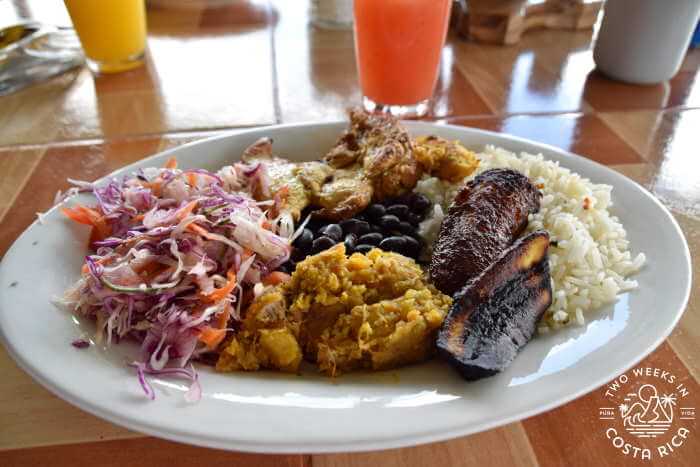
Hours
Cascadas Pozo Azul is open every day from 7:00 a.m. to 5:00 p.m.
What to Bring
We highly recommend sturdy sneakers or hiking boots. This is a technical hike. You will want good-gripping shoes. Also bring some insect repellent and sunscreen.
Plenty of food and water. We had to give one woman a granola bar to help her make it back up the steps because she didn’t have any energy!
Access
The property is about 800 meters (a half mile) off the main road. The road is dirt and bumpy, but you don’t need a 4×4 vehicle to access it. There is concrete on a few areas that are steeper.
Note that there are other waterfalls with a similar name in the Bajos del Toro area, which can make it confusing. On Google Maps, the name of these waterfalls is Cascada Pozo Azul. Here is the Google Maps link.
Dogs
The property is pet friendly. You can bring your dog to hike the trail. Some locals who were hiking at the same time as us brought their small dog and it was cruising along the trail. We also saw some locals carrying a cat!
Accommodations
For an authentic experience, you could stay at one of few small cabinas (cabins) on the property. Next to the cabinas is a freshwater swimming pool and some changing rooms that you are free to use with your admission ticket.
You can find more information about the cabins on their Facebook page.
Conclusion
Cascadas Pozo Azul is a gorgeous property with that offers an authentic experience to see one of Costa Rica’s most amazing waterfalls. If you’re looking for a more challenging hike, we highly recommend it.
Have a question about visiting Cascadas Pozo Azul? Leave a comment below.
Looking for more information to plan your trip to Costa Rica? Check out these posts:
Blue Falls of Costa Rica: Cataratas Las Gemelas – This is another beautiful waterfall in Bajos del Toro with unique blue water.
10 Day Pack Essentials for Costa Rica: Read our tips for what to bring on hikes like this one.
9 Off-the-Beaten-Path Destinations in Costa Rica: Check out our recommendations for more lesser-known towns to visit in Costa Rica.
